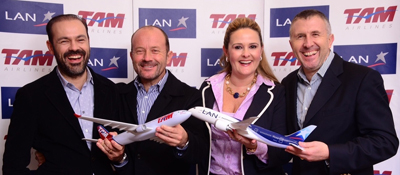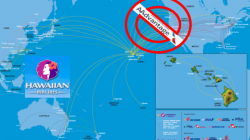
LATAM board of directors chair Mauricio Rolim Amaro, LAN CEO Ignacio Cueto, TAM board chair Maria Claudia Amaro, LATAM CEO Enrique Cueto. Courtesy, LAN Airlines. Image courtesy of Air Transport World.
It’s official: LAN and TAM Airlines have finally completed their merger transaction to create LATAM Airlines Group.
The combined carrier will now represent the largest airline in Latin America, offering passengers access to 150 destinations in 22 countries worldwide. LAN is currently based in Las Condes, Chile, a suburb of capital city Santiago, while TAM is based in São Paulo, Brazil. LATAM will keep both its Santiago and São Paulo headquarters. Enrique Cueto, who was formerly LAN’s CEO, will remain as CEO for LATAM as well.
While the merger announcement has been known for sometime, arguably one of the largest consideration points remains surrounding the combined carriers’ alliance election. Currently, LAN is a OneWorld member, while TAM is a Star Alliance member. However, as part of a regulatory measure of approval for the merger, in concordance with a decision made by Chile’s antitrust court TDLC, TAM has been mandated to shift alliances within 24 months. The condition stated that LATAM cannot be in the same global alliance as Avianca-TACA, which represents four carriers based in Colombia, Costa Rica, El Salvador, and Peru. Avianca-TACA officially joined Star Alliance yesterday, along with Panama-based COPA Airlines and its Colombian subsidiary, AeroRepública.
As such, TAM cannot legally remain in Star and it is not possible for LAN to leave OneWorld for Star. Speculation has continued to indicate that the combined carrier will likely fully-integrate into OneWorld, as LAN’s entrenchment in OneWorld very deep, tracing roots back to the early 2000’s. LAN’s relative importance to OneWorld is arguably far greater than TAM’s current position in Star, given that the latter has only been a Star member since May 2010.
Moreover, LAN is very well connected OneWorld-affiliated carriers and hubs, operating services on its own metal or via code-share agreements into Madrid Barajas airport in Spain (a hub for International Airlines Group member Iberia) as well as Miami International Airport, Dallas/Ft. Worth International Airport, New York Kennedy International, and Los Angeles International (hubs for American Airlines). Those ties have already harnessed lucrative partnerships and growth opportunities for traffic between Europe, North America and Latin America.
TAM will have to pay a $25 million exit fee in order to leave Star. OneWorld does not impose exit fees for any of their members.
In the mean time, TAM may be unaligned for a period of time (which is perfectly valid, as they are not required to maintain any alliance memberships aside from Star). However, logically it would appear that for that sake of benefits, the carrier will need to join an alliance at some stage.
Meanwhile, the entrance of Avianca-TACA and COPA Airlines into Star Alliance will help recover the loss of TAM over the course of time, positioning the global alliance into key high-growth markets in the Central and Northern South American regions. However, OneWorld has far more to lose if LAN were to exit the alliance and remain unaligned with TAM as part of the LATAM creation. LATAM has announced that they will make a decision within 6 to 12 months in regards to TAM’s membership selection, if not the combined carrier as a whole. In the mean time, people will be waiting anxiously to see what the alliance decision will be, given the massive importance of TAM in the Brazilian market as well as the major role LAN plays in OneWorld. It can either go very well in OneWorld’s favor, or represent a huge blow if LATAM were to exit entirely.
In the mean time, congrats to LATAM for a successful completion of the merger, as today represents a huge milestone in the histories of both carriers.
Air Transport World: LAN/TAM complete merger under LATAM Airlines Group
Air Transport World: TAM absent from Star events as LATAM alliance decision nears


